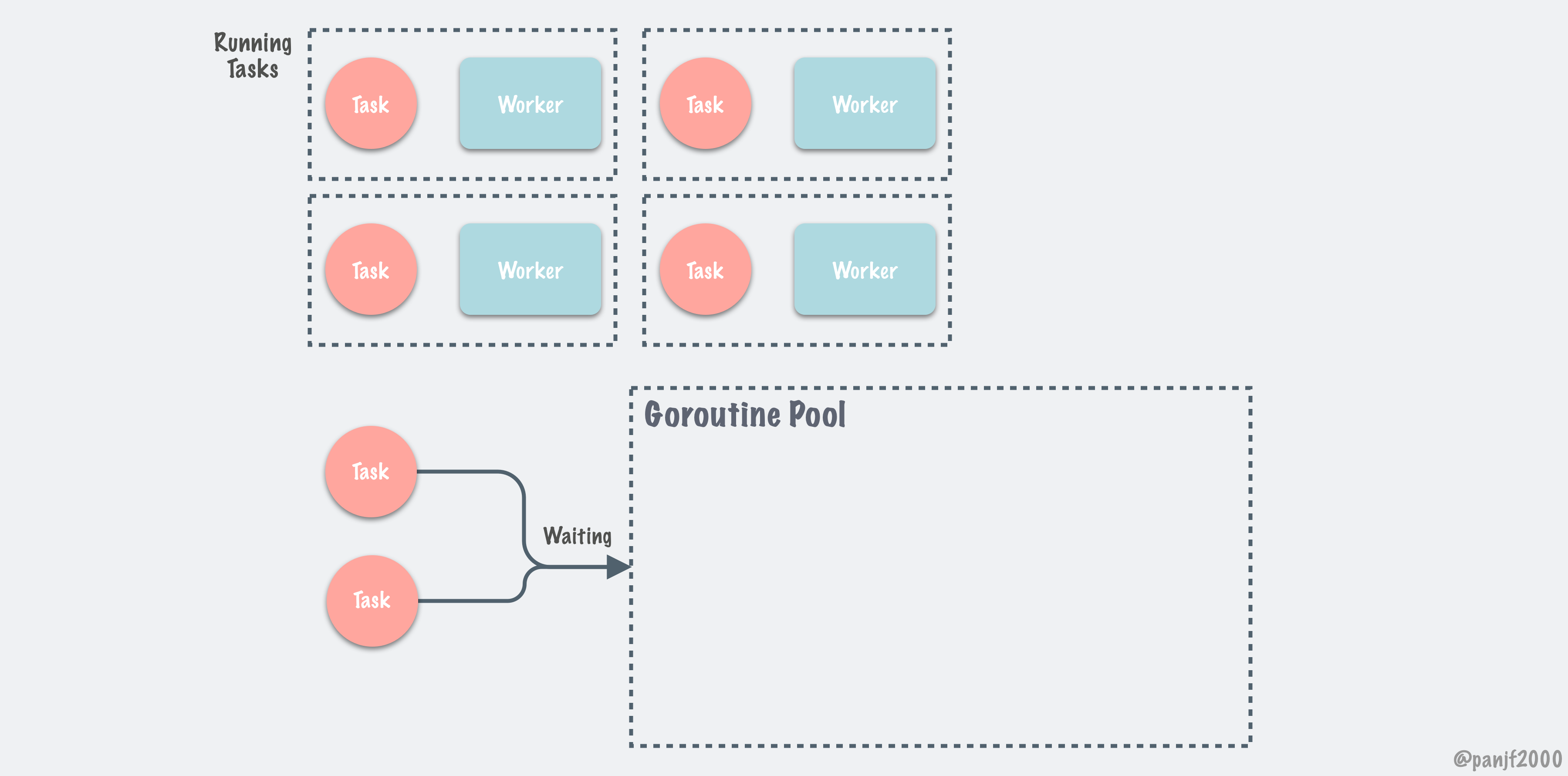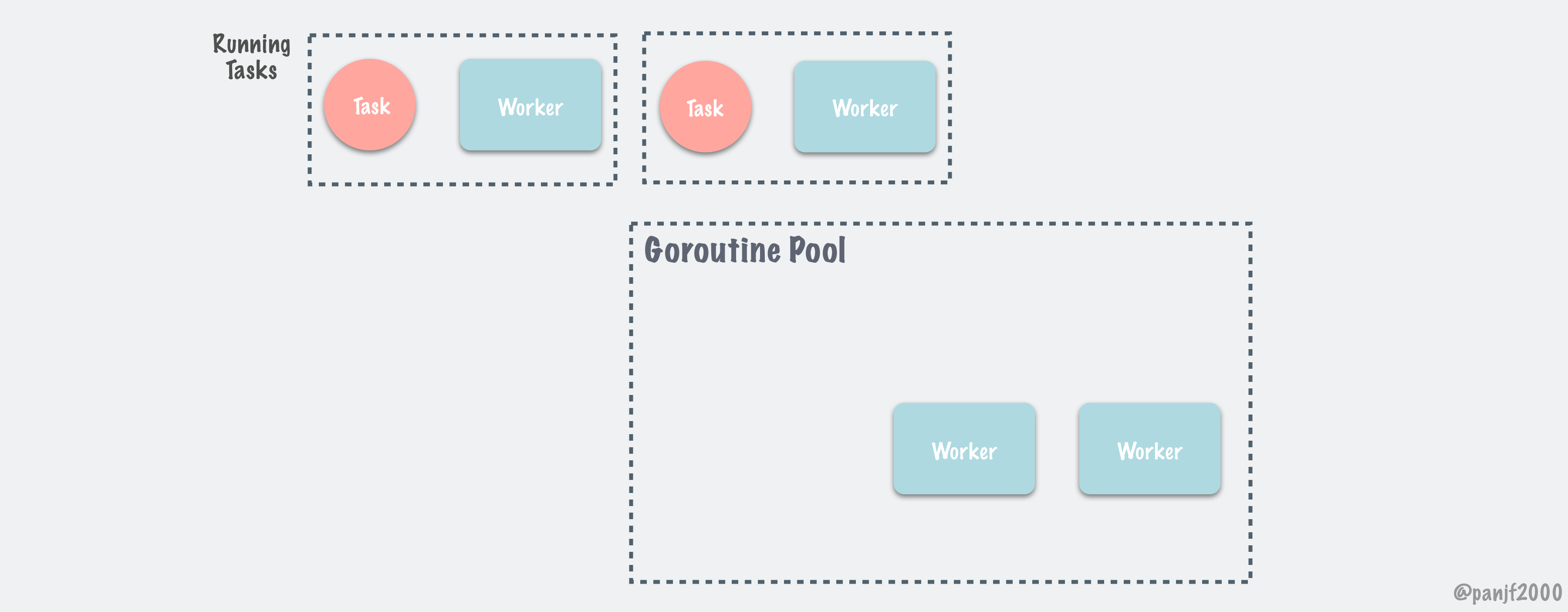Top Related Projects
🚀 gnet is a high-performance, lightweight, non-blocking, event-driven networking framework written in pure Go.
Quick Overview
The panjf2000/ants project is a high-performance, lightweight, and scalable Go concurrency library that provides a simple and efficient way to manage and coordinate goroutines (lightweight threads in Go). It is designed to help developers write concurrent and parallel programs in Go with ease.
Pros
- High Performance: The library is optimized for performance, allowing for efficient management of a large number of goroutines.
- Simplicity: The API is straightforward and easy to use, making it accessible for developers of all skill levels.
- Scalability: The library can handle a large number of goroutines, making it suitable for building scalable applications.
- Flexibility: The library provides a variety of features and options, allowing developers to customize the behavior of the goroutines to fit their specific needs.
Cons
- Limited Documentation: The project's documentation could be more comprehensive, which may make it challenging for new users to get started.
- Lack of Detailed Examples: While the project provides some examples, more detailed and diverse examples would be helpful for developers to understand the library's capabilities.
- Potential Learning Curve: Developers who are new to Go or concurrent programming may need to invest some time to fully understand the concepts and best practices involved in using the library.
- Potential Vendor Lock-in: By using this specific library, developers may become dependent on it, which could make it difficult to switch to alternative solutions in the future.
Code Examples
Here are a few code examples demonstrating the usage of the panjf2000/ants library:
- Creating a Worker Pool:
package main
import (
"fmt"
"time"
"github.com/panjf2000/ants/v2"
)
func main() {
// Create a worker pool with a maximum of 10 goroutines
p, _ := ants.NewPoolWithFunc(10, func(i interface{}) {
// Simulate some work
time.Sleep(time.Second)
fmt.Println("Processed task:", i.(int))
})
defer p.Release()
// Submit tasks to the worker pool
for i := 0; i < 100; i++ {
_ = p.Invoke(i)
}
// Wait for all tasks to complete
time.Sleep(time.Second * 12)
}
- Using a Context to Cancel Tasks:
package main
import (
"context"
"fmt"
"time"
"github.com/panjf2000/ants/v2"
)
func main() {
// Create a worker pool with a maximum of 10 goroutines
p, _ := ants.NewPoolWithFunc(10, func(i interface{}) {
// Simulate some work
time.Sleep(time.Second * 3)
fmt.Println("Processed task:", i.(int))
})
defer p.Release()
// Create a context with a 5-second timeout
ctx, cancel := context.WithTimeout(context.Background(), time.Second*5)
defer cancel()
// Submit tasks to the worker pool with the context
for i := 0; i < 100; i++ {
_ = p.Submit(ctx, i)
}
// Wait for all tasks to complete or the context to be canceled
<-ctx.Done()
fmt.Println("All tasks completed or canceled.")
}
- Dynamically Adjusting the Pool Size:
package main
import (
"fmt"
"time"
"github.com/panjf2000/ants/v2"
)
func main() {
// Create a worker pool with an initial size of 5 goroutines
p, _ := ants.NewPoolWithFunc(5, func(i interface{}) {
// Simulate some work
time.Sleep(time.Second)
fmt.Println("Processed task:", i.(int))
})
defer p.Release()
// Submit tasks to the worker pool
for i := 0; i < 100; i++ {
_
Competitor Comparisons
🚀 gnet is a high-performance, lightweight, non-blocking, event-driven networking framework written in pure Go.
Pros of gnet
- gnet is a high-performance, non-blocking, event-driven networking framework for Go.
- gnet provides a simple and intuitive API for building network applications.
- gnet supports a wide range of network protocols, including TCP, UDP, and WebSocket.
Cons of gnet
- gnet may have a steeper learning curve compared to Ants, as it provides more advanced features and functionality.
- gnet may have a higher memory footprint than Ants, depending on the complexity of the application.
Code Comparison
Here's a brief comparison of the code for a simple TCP server in both Ants and gnet:
Ants:
func main() {
ant.Run(func(c *ant.Conn) {
c.Write([]byte("Hello, World!"))
})
}
gnet:
func main() {
_ = gnet.Serve(new(echoServer), "tcp://0.0.0.0:8080")
}
type echoServer struct{}
func (es *echoServer) React(frame []byte, c gnet.Conn) (out []byte, action gnet.Action) {
return frame, gnet.None
}
Convert  designs to code with AI
designs to code with AI

Introducing Visual Copilot: A new AI model to turn Figma designs to high quality code using your components.
Try Visual CopilotREADME
English | ä¸æ
ð Introduction
Library ants implements a goroutine pool with fixed capacity, managing and recycling a massive number of goroutines, allowing developers to limit the number of goroutines in your concurrent programs.
ð Features:
- Managing and recycling a massive number of goroutines automatically
- Purging overdue goroutines periodically
- Abundant APIs: submitting tasks, getting the number of running goroutines, tuning the capacity of the pool dynamically, releasing the pool, rebooting the pool, etc.
- Handle panic gracefully to prevent programs from crash
- Efficient in memory usage and it may even achieve higher performance than unlimited goroutines in Go
- Nonblocking mechanism
- Preallocated memory (ring buffer, optional)
ð¡ How ants works
Flow Diagram

Activity Diagrams




𧰠How to install
For ants v1
go get -u github.com/panjf2000/ants
For ants v2 (with GO111MODULE=on)
go get -u github.com/panjf2000/ants/v2
ð How to use
Check out the examples for basic usage.
Functional options for pool
ants.Optionscontains all optional configurations of the ants pool, which allows you to customize the goroutine pool by invoking option functions to set up each configuration in NewPool/NewPoolWithFunc/NewPoolWithFuncGeneric method.
Check out ants.Options and ants.Option for more details.
Customize pool capacity
ants supports customizing the capacity of the pool. You can call the NewPool method to instantiate a Pool with a given capacity, as follows:
p, _ := ants.NewPool(10000)
Submit tasks
Tasks can be submitted by calling ants.Submit
ants.Submit(func(){})
Tune pool capacity at runtime
You can tune the capacity of ants pool at runtime with ants.Tune:
pool.Tune(1000) // Tune its capacity to 1000
pool.Tune(100000) // Tune its capacity to 100000
Don't worry about the contention problems in this case, the method here is thread-safe (or should be called goroutine-safe).
Pre-malloc goroutine queue in pool
ants allows you to pre-allocate the memory of the goroutine queue in the pool, which may get a performance enhancement under some special certain circumstances such as the scenario that requires a pool with ultra-large capacity, meanwhile, each task in goroutine lasts for a long time, in this case, pre-mallocing will reduce a lot of memory allocation in goroutine queue.
// ants will pre-malloc the whole capacity of pool when calling ants.NewPool.
p, _ := ants.NewPool(100000, ants.WithPreAlloc(true))
Release pool
pool.Release()
or
pool.ReleaseTimeout(time.Second * 3)
Reboot pool
// A pool that has been released can be still used after calling the Reboot().
pool.Reboot()
âï¸ About sequence
All tasks submitted to ants pool will not be guaranteed to be addressed in order, because those tasks scatter among a series of concurrent workers, thus those tasks would be executed concurrently.
ð Contributors
Please read our Contributing Guidelines before opening a PR and thank you to all the developers who already made contributions to ants!
ð License
The source code in ants is available under the MIT License.
ð Relevant Articles
- Goroutine 并åè°åº¦æ¨¡å深度解æä¹ææ¸ä¸ä¸ªé«æ§è½ goroutine æ±
- Visually Understanding Worker Pool
- The Case For A Go Worker Pool
- Go Concurrency - GoRoutines, Worker Pools and Throttling Made Simple
ð¥ Use cases
business corporations
Trusted by the following corporations/organizations.

|

|

|

|

|

|

|

|

|

|

|

|

|

|

|

|

|

|

|
If you're also using ants in production, please help us enrich this list by opening a pull request.
open-source software
The open-source projects below do concurrent programming with the help of ants.
- gnet: A high-performance, lightweight, non-blocking, event-driven networking framework written in pure Go.
- milvus: An open-source vector database for scalable similarity search and AI applications.
- nps: A lightweight, high-performance, powerful intranet penetration proxy server, with a powerful web management terminal.
- TDengine: TDengine is an open source, high-performance, cloud native time-series database optimized for Internet of Things (IoT), Connected Cars, and Industrial IoT.
- siyuan: SiYuan is a local-first personal knowledge management system that supports complete offline use, as well as end-to-end encrypted synchronization.
- osmedeus: A Workflow Engine for Offensive Security.
- jitsu: An open-source Segment alternative. Fully-scriptable data ingestion engine for modern data teams. Set-up a real-time data pipeline in minutes, not days.
- triangula: Generate high-quality triangulated and polygonal art from images.
- teler: Real-time HTTP Intrusion Detection.
- bsc: A Binance Smart Chain client based on the go-ethereum fork.
- jaeles: The Swiss Army knife for automated Web Application Testing.
- devlake: The open-source dev data platform & dashboard for your DevOps tools.
- matrixone: MatrixOne is a future-oriented hyper-converged cloud and edge native DBMS that supports transactional, analytical, and streaming workloads with a simplified and distributed database engine, across multiple data centers, clouds, edges and other heterogeneous infrastructures.
- bk-bcs: BlueKing Container Service (BCS, same below) is a container management and orchestration platform for the micro-services under the BlueKing ecosystem.
- trueblocks-core: TrueBlocks improves access to blockchain data for any EVM-compatible chain (particularly Ethereum mainnet) while remaining entirely local.
- openGemini: openGemini is an open-source,cloud-native time-series database(TSDB) that can be widely used in IoT, Internet of Vehicles(IoV), O&M monitoring, and industrial Internet scenarios.
- AdGuardDNS: AdGuard DNS is an alternative solution for tracker blocking, privacy protection, and parental control.
- WatchAD2.0: WatchAD2.0 æ¯ 360 ä¿¡æ¯å®å ¨ä¸å¿å¼åçä¸æ¬¾é对åå®å ¨çæ¥å¿åæä¸çæ§ç³»ç»ï¼å®å¯ä»¥æ¶éææåæ§ä¸çäºä»¶æ¥å¿ãç½ç»æµéï¼éè¿ç¹å¾å¹é ãåè®®åæãåå²è¡ä¸ºãæææä½åèç½è´¦æ·çæ¹å¼æ¥æ£æµåç§å·²ç¥ä¸æªç¥å¨èï¼åè½è¦çäºå¤§é¨åç®åç常è§å ç½åæ¸éææ³ã
- vanus: Vanus is a Serverless, event streaming system with processing capabilities. It easily connects SaaS, Cloud Services, and Databases to help users build next-gen Event-driven Applications.
- trpc-go: A pluggable, high-performance RPC framework written in Golang.
- motan-go: Motan is a cross-language remote procedure call(RPC) framework for rapid development of high performance distributed services. motan-go is the golang implementation of Motan.
All use cases:
If you have ants integrated into projects, feel free to open a pull request refreshing this list of use cases.
ð JetBrains OS licenses
ants has been being developed with GoLand under the free JetBrains Open Source license(s) granted by JetBrains s.r.o., hence I would like to express my thanks here.
ð° Backers
Support us with a monthly donation and help us continue our activities.
ð Sponsors
Become a bronze sponsor with a monthly donation of $10 and get your logo on our README on GitHub.
âï¸ Buy me a coffee
Please be sure to leave your name, GitHub account, or other social media accounts when you donate by the following means so that I can add it to the list of donors as a token of my appreciation.
ð Sponsorship
Top Related Projects
🚀 gnet is a high-performance, lightweight, non-blocking, event-driven networking framework written in pure Go.
Convert  designs to code with AI
designs to code with AI

Introducing Visual Copilot: A new AI model to turn Figma designs to high quality code using your components.
Try Visual Copilot A goroutine pool for Go
A goroutine pool for Go






